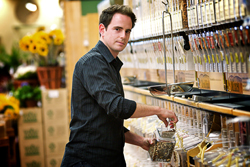April 28, 2009
[audio:http://sustainability.asu.edu/media/podcasts/Brendan-Beardsley-Podcast.mp3]
You probably know that buying in bulk is a great way to reduce packaging and get a rock bottom price. Another perk is that it keeps spoiled food and dollars from going down the drain -- that's because bulk bins allow you to select only the amount you need.

But here's the rub. The store-supplied baggies you fill with bulk foods seem convenient at first, only to turn out treacherous. They rip, they spill, they look awful on your kitchen shelves, and they end up as another petroleum-based product in the landfill. What's an Earth-minded shopper to do?
Brendan Beardsley, a master's student in ASU's College of Design, has worked up a sustainable solution. As part of his thesis work on the transportation, storage, and distribution of bulk goods, he has designed a better bulk foods container.
“Thirty percent of the total municipal waste stream, roughly, is from packaging waste and 15 percent is food packaging waste specifically,” notes Beardsley. “If you take your own jars, you can refill them at the store… and completely eliminate that extra packaging.”
Beardsley knows his stuff. Just days before his thesis defense, his mind was (not surprisingly) full of facts and statistics about packaging waste and the impacts, costs, pros, and cons associated with buying in bulk. He had analyzed numerous reusable and disposable containers, noting the best and worst features of each. He had studied step by step the process of buying in bulk, and he had devised a system for implementing his design.
Beardsley’s bulk foods container is a jar made of glass that has 6 percent of the environmental impact of paper and just 7 percent of the impact of plastic. Worried about breakage? He has also designed a special bag for safely carrying the containers to and from the store.
What makes his jar special? It’s the right size for inserting a measuring cup or reaching in to grab a snacky handful. The lid doesn’t pop off if you lift it from the top – ensuring that your glass jar will live to make another trip to the store. The jars come in a variety of sizes, and they’re all stackable so your cupboard will be neatly organized. Plus glass is easy to clean and sanitize.
Beardsley has developed a plan for implementing his design that is similar to the process used by dairy stores that sell milk in glass jars. You can always use and reuse your own container, but if you forget to bring a clean jar from home, you can pick up another from the store. And if you accumulate more containers than you need, just return the empty and get your deposit back.
“It feels very empowering to take your own container into a store, refill it with something, check out, take it home, and just be done,” says Beardsley. “There’s no waste associated with that other than washing it out, which uses some soap and hot water. There’s transportation involved, but that would be involved with everything else.”
Using your own container is a time-saver, too. “You don’t have to transfer [your food] because it’s already in the container that you want. It’s nice to put something on the shelf and be done.”

